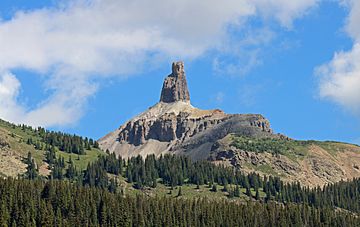Lizard Head facts for kids
Quick facts for kids Lizard Head |
|
|---|---|
 |
|
| Highest point | |
| Elevation | 13,119 ft (3,999 m) |
| Prominence | 1,134 ft (346 m) |
| Isolation | 1.93 mi (3.11 km) |
| Geography | |
| Location | Dolores and San Miguel counties, Colorado, United States |
| Parent range | San Miguel Mountains |
| Topo map | USGS 7.5' topographic map Mount Wilson, Colorado |
| Geology | |
| Age of rock | Oligocene |
| Mountain type | Ash flow tuff |
| Climbing | |
| First ascent | 1920 by Albert Ellingwood and Barton Hoag |
| Easiest route | Technical climb; class 5.8 |
Lizard Head is a unique mountain summit found in the San Miguel Mountains range. This range is part of the larger Rocky Mountains in North America. Standing at 13,119-foot (3,999 m) tall, it's known as a "thirteener" because it's over 13,000 feet high.
Lizard Head is located in the Lizard Head Wilderness area. It's about 6.8 miles (11.0 km) west of the Town of Ophir, Colorado, United States. The mountain sits right on the border between San Juan National Forest and Dolores County on one side, and Uncompahgre National Forest and San Miguel County on the other.
Contents
About Lizard Head Mountain
Lizard Head is just southeast of three famous Colorado mountains called "fourteeners" (peaks over 14,000 feet). These are Mount Wilson, Wilson Peak, and El Diente Peak. Even though Lizard Head is only the 556th highest peak in Colorado, its tall, pointy shape makes it one of the most amazing to look at.
You can find Lizard Head about 2.84 mi (4.57 km) northwest of Colorado State Highway 145 at Lizard Head Pass. There's a trail called Lizards Head Trail that starts near Trout Lake. It climbs west along Black Face Mountain ridge and goes past the south side of Lizard Head towards Wilson Peak.
Did you know? The peak was once used in the logo for the Rio Grande Southern Railroad!
How Was Lizard Head Formed?
The rocky spire of Lizard Head looks like an old, worn-down volcanic plug. A volcanic plug is when magma hardens inside a volcano's vent. However, Lizard Head is actually made of different kinds of volcanic rock. These rocks are called ash flows, which are made from hot ash and gas that erupted from a volcano a very long time ago. These volcanic rocks are from the Oligocene age, which means they are millions of years old. They sit on top of even older sedimentary rocks from the Eocene age.
Climbing Lizard Head
Climbing Lizard Head is known as one of the most difficult mountain climbs in Colorado. The very first time someone successfully climbed it was a truly memorable and challenging adventure.
One of the first climbers, Albert Ellingwood, described the mountain as being incredibly loose and crumbly. He said that the whole surface of the rock was loose, and small rocks would fall off easily, like needles from an old Christmas tree. He even mentioned that sometimes, without anyone touching it, small rock slides would happen.
Despite these serious dangers, the first climbing team managed to reach the top and get back down safely. This showed amazing mountaineering skill and bravery!
How Lizard Head Changed
The way Lizard Head looks today is different from how it used to be. A big landslide happened in 1911, which changed its appearance a lot.
The Mancos Times-Tribune newspaper reported on December 29, 1911:
Lizard Head has fallen
The skyline of the mountains to the southwest of Telluride was changed last night when through some mighty upheaval of nature, the taller spire of Lizard Head fell with a roar to the depths below.
During the night people living on the mesas near Ophir heard a sliding, grinding noise, which disturbed the atmosphere and gave the impression of an earthquake. This morning they discovered that the upstanding rock which had been given the name of Lizard Head was gone.
The smaller spire which was formerly inconspicuous by the side of the head is now standing single and alone, pointing to the sky, a long sentinel of last night’s upheaval. Millions of tons of rocks, conglomerate and earth went down without apparent cause or reason.
There are old photos of the peak from before the landslide. These "before-and-after" pictures show that the mountain looked quite different, especially from the north side. The older photos show a taller, more squared-off peak that looked more like a lizard's head. Pictures taken from the south don't show as much change, which means most of the collapse happened on the northern side of the mountain.
Historical Names
- Lizard Head
- Lizard Head Peak
- Lizards Head


